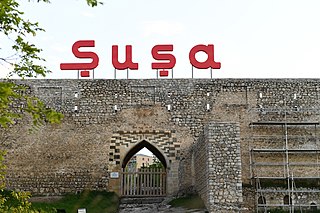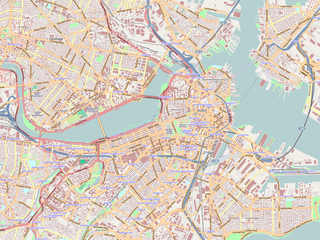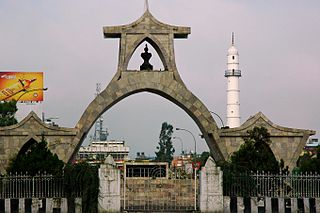 W
WA gate or gateway is a point of entry to or from a space enclosed by walls. The word derived from old Norse "gat" meaning road or path; But other terms include yett and port. The concept originally referred to the gap or hole in the wall or fence, rather than a barrier which closed it. Gates may prevent or control the entry or exit of individuals, or they may be merely decorative. The moving part or parts of a gateway may be considered "doors", as they are fixed at one side whilst opening and closing like one.
 W
WAghoghlan Gate, also known as the Mukhtar Gate or the Shushikend Gate, is one of the four entrance gates to the Shusha fortress in the homonymous city in the Republic of Azerbaijan, also known to Armenians as Shushi.
 W
WThe Amsterdam Gate formed the entrance to the Castle Square south of Batavia Castle. The gate existed from 1744 up to the 1950s in what is now known as Kota, Jakarta, where it would have stood near the intersection of Jalan Nelayan Timur and Jalan Cengkeh.
 W
WThe Ancient Gates of Ganja were a masterpiece of craftsmanship of the 10th to 11th centuries.
 W
WThe Assassin's Gate is one of four primary points of entry to the Green Zone in Baghdad, Iraq.
 W
WThe Balawat Gates are three sets of decorated bronze bands that had adorned the main doors of several buildings at Balawat, dating to the reigns of Ashurnasirpal II and Shalmaneser III. Their extensive use of narrative art depicting the exploits of Assyrian kings has cemented their position as some of the most important surviving works of art of the Neo-Assyrian Empire, comparable to the extensive Assyrian palace reliefs. When the Neo-Assyrian Empire fell in 614-612 BC, Balawat was destroyed. The wooden elements of the gates decomposed, leaving only the bronze bands. The remains of two sets of gates can be found in the British Museum's collection, those from the Temple of Mamu are housed in the Mosul Museum. Small sections of the Shalmaneser bronze door bands are also at the Walters Art Museum in Baltimore and in the Istanbul Archaeology Museums.
 W
WBatticaloa Gate is monument, which was used as port to connect Puliyanthivu (island) with the mainland of Batticaloa, Sri Lanka. The place believed as landing site of Rev. William Ault, who was the first Methodist missionary to Batticaloa, in 1814. His statue can be seen closer to the Batticaloa Gate.
 W
WA bent or indirect entrance is a defensive feature in medieval fortification. In a castle with a bent entrance, the gate passage is narrow and turns sharply. Its purpose is to slow down attackers attempting to rush the gate and impede the use of battering rams against doors. It is often combined with means for an active defence, such as machicolations, in effect confining intruders to a narrow killing zone. Its defensive function is related to that of a barbican in front of the gate.
 W
WThe Chalke Gate, was the main ceremonial entrance (vestibule) to the Great Palace of Constantinople in the Byzantine period. The name, which means "the Bronze Gate", was given to it either because of the bronze portals or from the gilded bronze tiles used in its roof. The interior was lavishly decorated with marble and mosaics, and the exterior façade featured a number of statues. Most prominent was an icon of Christ which became a major iconodule symbol during the Byzantine Iconoclasm, and a chapel dedicated to the Christ Chalkites was erected in the 10th century next to the gate. The gate itself seems to have been demolished in the 13th century, but the chapel survived until the early 19th century.
 W
WCity Gate, Chittagong is a gate located in Chittagong. It is a symbol of city area and welcomes every visitor to the city. It connects Chittagong City with Sitakunda Upazila to the north. Colonel Hat area is next to the gate. There are some real state building located in the area. Local police set up a checkpost near city gate area. They used to search civilians while entering to city. Recently, the panel mayor took some steps to beautify the City gate area.
 W
WCleopatra's Gate is a city gate of Tarsus, in Mersin Province, Turkey, named after the Egyptian (Ptolemaic) queen Cleopatra VII.
 W
WGanja Gate is one of the four entrance gates to the Shusha fortress in Shusha—known to its historical Armenian population as Shushi—a city in the Nagorno-Karabakh region, currently part of Azerbaijan. The fortress and the city were part of the Nagorno-Karabakh Autonomous Oblast; they later were under the control of the self-proclaimed Republic of Artsakh, from the Battle of Shusha on May 8, 1992 until 8 November 2020, when the Azerbaijani Armed Forces retook the city after a 3-day long battle.
 W
WThe Gate of Dawn , or Sharp Gate is a city gate in Vilnius, the capital of Lithuania, and one of its most important religious, historical and cultural monuments. It is a major site of Catholic pilgrimage in Lithuania.
 W
WThe Gates of Hell is a monumental sculptural group work by French artist Auguste Rodin that depicts a scene from the Inferno, the first section of Dante Alighieri's Divine Comedy. It stands at 6 metres high, 4 metres wide and 1 metre deep (19.7×13.1×3.3 ft) and contains 180 figures. The figures range from 15 centimetres (6 in) high up to more than one metre (3 ft). Several of the figures were also cast as independent free-standing statues.
 W
WThe Temple Mount, located in Jerusalem, can be accessed through twelve gates, and contains a further six sealed gates. This list does not include the Gates of the Old City of Jerusalem around the external walls.
 W
WA guard stone, jostle stone or chasse-roue, is a projecting metal, concrete, or stone exterior architectural element located at the corner and/or foot of gates, portes-cochères, garage entries, and walls to prevent damage from vehicle tires and wheels.
 W
WHolworthy Gate, also known as the 1876 Gate, is a gate on the Harvard University campus in Cambridge, Massachusetts. It is named after English merchant Matthew Holworthy. An inscription on the gate reads, "In Memory of Dear Old Times."
 W
WThe Ishtar Gate (Arabic: بوابة عشتار) was the eighth gate to the inner city of Babylon. It was constructed in about 575 BCE by order of King Nebuchadnezzar II on the north side of the city. It was part of a grand walled processional way leading into the city. The walls were finished in glazed bricks mostly in blue, with animals and deities in low relief at intervals, these also made up of bricks that are molded and colored differently.
 W
WThe Kholm Gate is a gate of the citadel of Brest Fortress in Brest, Belarus. Originally built in the 19th Century during Russian rule, as one of four gates. The exterior facade, facing the southern branch of the Mukhavets River, was designed in a classical style decorated with turrets and a medallion. The Kholm Gate was named after the town of Chełm, which was directly connected to the gate by a road, with Kholm being the East Slavic version of the town's name. In June 1941, Brest Fortress was the site of heavy fighting during the Defense of Brest Fortress, early into the German invasion of the Soviet Union during World War II. Kholm Gate's facade was badly damaged, but survived relatively intact compared to rest of the fortress and is one of the two surviving gates, along with the Tiraspol Gate. After the war, Kholm Gate was awarded the status of "Hero Fortress" as part of Brest Fortress, one of only twelve places to receive the award in the Soviet Union.
 W
WKuninkaanportti or Kungsporten is the principal entrance to the fortress Suomenlinna outside Helsinki. It is on the southernmost island of Suomenlinna, in front of the Kustaanmiekka strait, and is considered the main symbol of Suomenlinna.
 W
WLaurinc Gate was a medieval town gate in the historical Old Town of Bratislava, the capital of Slovakia. It was built in the 14th century and demolished by the order of Empress Maria Theresa of Austria in the 18th century together with most of the city walls, because the inner walls were limiting the town's growth. It was named after Saint Lawrence.
 W
WThe Mandelbaum Gate is a former checkpoint between the Israeli and Jordanian sectors of Jerusalem, just north of the western edge of the Old City along the Green Line. The first checkpoint for the Hashemite Kingdom of Jordan/Israel Mixed Armistice Commission at the Mandelbaum Gate, from the close of the 1948 Arab–Israeli War in 1949 until August 1952, was moved from the Israeli side of the Gate to the Demilitarised Zone after the "Barrel Incident". The second checkpoint existed until the 1967 Six-Day War. The Gate became a symbol of the divided status of the city.
 W
WMatthias Gate, or Matthias' Gate, is a gate between the first and the second courtyards of Prague Castle in Prague, Czech Republic. It was erected by Matthias, Holy Roman Emperor in 1614.
 W
WMeyer Gate is a 1901 gate on the Harvard University campus, in Cambridge, Massachusetts, United States. The gate has a traditional design and borders the Harvard Yard and The Plaza. It is named after George von Lengerke Meyer.
 W
WIn Bratislava, Slovakia, Michael's Gate is the only city gate that has been preserved of the medieval fortifications and ranks among the oldest town buildings. Built about the year 1300, its present shape is the result of baroque reconstructions in 1758, when the statue of St. Michael and the Dragon was placed on its top. The tower houses the Exhibition of Weapons of Bratislava City Museum.
 W
WMonkodonja is a hill fort occupied about 1800–1200 BC during the Bronze Age, located near the city of Rovinj in the Croatian region of Istria.
 W
WPísek Gate, also called Bruska Gate is a former city gate of Baroque fortification of Prague, Czech Republic. Once belonging to the fortification section called Marian Walls it is located in K Brusce Street in the Hradčany neighbourhood, not far from Hradčanská metro station. Other sights in the vicinity include Royal Summer Palace or Villa Bílek. Nowadays Písek Gate is the only preserved gate of the city proper and one of four remaining of the whole fortification system.
 W
WThe Portas do Cerco is an area in Nossa Senhora de Fátima, Macau, China. Located on the northern tip of the Macau Peninsula, it is known by the Barrier Gate separating Macau from mainland China. The Portuguese built the gate in 1849 to replace a crumbling wall that the Chinese erected during the Ming dynasty in 1573. The Chinese built a garrisoned wall to control the flow of people and goods. It was the site of the Passaleão incident, a clash between the Qing dynasty and the Kingdom of Portugal in 1849 over the death of Macau's governor Ferreira do Amaral. Led by Colonel Mesquita, Portugal won the small battle which led to the extension of Macau's border northwards. At the limit of said expansion, the Portas do Cerco was built with the inscription "A pátria honrai, que a pátria vos contempla" on the façade on its inner arch in 1849. The Barrier Gate served as a de facto boundary, but the precise limits of Macau's border has never been formally demarcated.
 W
WThe Powder Tower or Powder Gate is a Gothic tower in Prague, Czech Republic. It is one of the original city gates. It separates the Old Town from the New Town.
 W
WA pylon is a monumental gate of an Egyptian temple. The word comes from the Greek term πυλών 'gate'. It consists of two pyramidal towers, each tapered and surmounted by a cornice, joined by a less elevated section enclosing the entrance between them. The gate was generally about half the height of the towers. Contemporary paintings of pylons show them with long poles flying banners.
 W
WThe Qeysarie gate is a historical gate in the main entrance of the Bazaar of Isfahan and Qeysarie Bazaar in Isfahan, Iran. The gate had had originally 3 floors, but the third floor was destroyed later. The destroyed third floor had been a Naqqarekhane. The gate was built in the 17th century during the Safavid era.
 W
WSahid Gate or Shahid Gate is a monument in Kathmandu, Nepal. As of 2016, there are five statues in the gate. Four men, namely Dharma Bhakta Mathema, Gangalal Shrestha, Dashrath Chand, and Shukraraj Shastri, who are considered martyrs since they stood against the 104-year-old Rana Regime, have their statues above their arms established here. On top of all is a statue of former King Tribhuvan, who, in B.S. 2007 cooperated with people to get democracy in the country.
 W
WSlip Gates, also known as Stang Stoops, Yatsteads or Stang Pole Gateways are a form of simple gate that once commonly in Europe controlled access to fields, lanes, etc. using removable cross-bars and two fixed posts, often of stone. The usually wood spars or stangs were slotted into grooves cut into the stone piers and held firmly in place at one end with wedges and on the other end by being placed in a deep square or circular socket. Most other gates are formed of a fuller frame; many instead have hinges.
 W
WThe Spanish Arch and the Caoċ Arch in Galway city, Ireland, are two remaining arches on the Ceann an Bhalla.
 W
WThe Sublime Porte, also known as the Ottoman Porte or High Porte, was a synecdoche for the central government of the Ottoman Empire.
 W
WThe Gates of Tashkent, in present-day Uzbekistan, were built around the town at the close of the 10th century, but did not survive to the present. The last gate was destroyed in 1890 as a result of the growth of the city, but some of the districts in Tashkent still bear the names of these gates.
 W
WThe Terespol Gate was one of the four gates leading into the Citadel of the Russian Brest Fortress. It was designed in a classic style in the early 19th century. It faces the Bug River. A suspension bridge was built here in the early 19th century to span the Bug River. The bridge was badly damaged in 1915 at World War I. Another bridge built here before 1941 was ruined during World War II. Now there is no bridge here, however, a new suspension bridge for pedestrian cross border traffic will be built in coming years.
 W
WWarren's Gate, first described by the nineteenth century surveyor Charles Warren, is an ancient entrance into the Temple platform in Jerusalem which lies about 150 feet (46 m) into the Western Wall Tunnel. In the Second Temple period, the gate led to a tunnel and staircase onto the Temple Mount.
 W
WThe Western City Gate, also known as the Genex Tower is a 36-story skyscraper in Belgrade, Serbia, which was designed in 1977 by Mihajlo Mitrović in the brutalist style. It is formed by two towers connected with a two-story bridge and revolving restaurant at the top. It is 117 m (384 ft) tall and is the second-tallest high-rise in Belgrade after Ušće Tower.